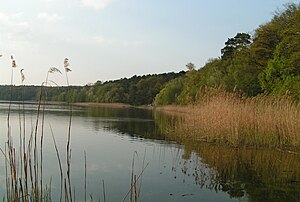Wielkopolski National Park
| 'Wielkopolski' National Park | |
|---|---|
| Wielkopolski Park Narodowy | |
|
IUCN category II (national park)
|
|

|
|
| Location | Greater Poland Voivodeship, Poland |
| Nearest city | Puszczykowo |
| Coordinates | 52°16′N 16°47′E / 52.267°N 16.783°ECoordinates: 52°16′N 16°47′E / 52.267°N 16.783°E |
| Area | 75.84 km2 (29.28 sq mi) |
| Established | 1957 |
| Visitors | 1 000 000 |
| Governing body | Ministry of the Environment |
'Wielkopolski' National Park (Polish: Wielkopolski Park Narodowy, or the National Park of Greater Poland) is a National Park within the Wielkopolska (Greater Poland) region of west-central Poland, approximately 15 km (9 mi) south of the regional capital, Poznań. Together with the protective zone around it, it includes part of the Poznań Lakeland (Pojezierze Poznańskie) and parts of Poznań’s Warta Gorge (Poznański Przełom Warty).
The Park has its headquarters in the village of Jeziory.
Created in 1957 on an area of 52.44 km2 (20 sq mi), the Park currently covers 75.84 km2 (29 sq mi), of which over half (46.17 km²) is forested. Waters (mainly small lakes) cover 4.62 km2 (2 sq mi), and other types of land 25.05 km2 (10 sq mi). The Park contains 18 strictly protected areas.
The idea of creating a preserve here was first raised by Professor A. Wodziczko in 1922. After 10 years of efforts, in 1932 two reserves were created: the first at Puszczykowo (original area 2.39 km²), and the second around Kociołek lake (1.89 km²). In 1933 on the hilltop of Osowa Góra a symbolic opening of the Wielkopolska National Park took place, however the Park was not officially created until 1957.
The landscape of the Park was strongly influenced by a glacier, which covered this area 70-10 thousand years ago. It is mainly flat - its highest hill - Osowa Góra, reaches only 132 m (433 ft) above sea level. The Park is split by several tunnel-valley lakes, which were created by the glacier. Among them there is one regarded as the most beautiful - Góreckie Lake, with two islands.
Of other interesting land formations, one must emphasize numerous, round hills as well as long, narrow hills which resemble rail mounds. Also, there are huge rocks, the biggest of which - Głaz Leśników, is regarded as a nature’s monument and as such is protected.
The main element of Park’s flora are species of Euro-Syberian kind, like pine (making up 70% of Park’s forests) as well as other forest plants. Soil here is of poor quality, only around waters it is better which enables plant life there to be more heterogeneous. Unique in its character is Skrzynka Lake, which is partly covered by a thick layer of peat-bogs.
...
Wikipedia


